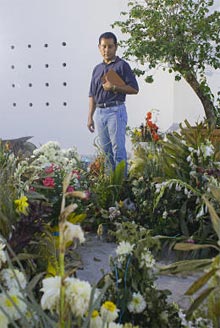
|  |  |  Editorials | Issues | July 2009 Editorials | Issues | July 2009  
With Mexico's Violence, Nothing is Sacred
 Dudley Althaus - Houston Chronicle Dudley Althaus - Houston Chronicle
go to original
July 02, 2009


| | Othon Carranza, rector of the seminary in Ciudad Altamirano, Mexico, visits the grave of priest Habacuc Hernandez, shown at top, who was shot repeatedly June 13. (Keith Dannemiller/Chronicle) |  |
Ciudad Altamirano, Mexico — A Roman Catholic priest described as a self-effacing servant of God has joined the more than 11,000 people slaughtered in Mexico, shot in the back by marauding gunmen.

Habacuc Hernandez was killed gangland style at the entrance to this narcotics-country town 160 miles south of Mexico City — along with two teenage recruits to the priesthood — reportedly by three men who forced the victims out of their pickup and shot them repeatedly.

“This is a beginning, an indication that they don’t respect anything,” said Othon Carranza, rector of the seminary where Hernandez worked as a recruiter and fundraiser. “They have threatened several of us. They think we know a lot of things because we hear confessions, or that we would tell people to rise against them.”

Just this week, the bishop of Cuernavaca, south of Mexico City, called on the Mexican attorney general’s office to investigate the June 16 disappearance of another parish priest, Martin Juarez.

“This has me very worried,” Bishop Florencio Olvera said Wednesday. “We pray that God illuminates the investigators and that they solve this.”

In a country of 90 million Catholics, the June killings and disappearance suggest no one is immune to Mexico’s bloodletting. Mobsters have told bishops to keep silent. Priests working in communities controlled by gangsters have been warned not to meddle in underworld affairs.

Hernandez’s death June 13 is the first of a clergyman linked directly to organized crime since the 1993 killing of Juan Jesus Posadas Ocampo, the cardinal in Guadalajara.

Assassins have killed more than 11,000 people amid Mexico’s 30-month campaign against organized crime, slaughtering gangsters, police officers, soldiers and occasional innocents with unfettered gusto.

Serving remote towns

In his work for the seminary, Hernandez traveled to small communities throughout the Altamirano Diocese, a huge area that includes some of Mexico’s more rugged and lawless mountains.

Like other local priests, colleagues say, Hernandez routinely traveled as much as 18 hours by car and horseback to minister to the diocese’s more remote villages.

His own roots — he was among 10 children born to a poor farming family in the mountains north of Altamirano and at one time worked illegally in Texas to save the money to pay for his religious studies — allowed Hernandez easy relations with often wary local people.

“He was very humble,” said Javier Castrejon, a priest who lived next to Hernandez at the seminary, where a funeral Mass for Hernandez drew a crowd of 6,000. “He was very much appreciated by people.”

The villages, towns and farms within the diocese’s boundaries — known collectively as “the hot lands” — have been famous as one of Mexico’s more violent areas. Long-standing family feuds, revenge killings and criminal gangs abound. Rival drug-trafficking organizations — producing marijuana and other narcotics in remote areas — have been warring in recent years.

An April battle near Arcelia, the town where Hernandez and the teenagers died, killed 15 gunmen and a soldier. Shootouts have become frequent on the streets of Altamirano, the town where the diocese is headquartered.

“This is a society that developed very isolated,” said Alejandro Galvan, 38, a priest who acts as the diocese spokesman and who knew Hernandez for 18 years. “There are a lot of families very rooted in violence.”

Fears of greater violence against the Catholic clergy surged this spring after the archbishop of Durango announced that “everyone except authorities” knows that notorious gangster Joaquin “El Chapo” Guzman is living in a mountain village in that state. Days after the statement made national news, two undercover military officers were found slain.

“Neither governments nor priests are ever going to be able to handle El Chapo,” read a placard left with the bodies

No one arrested

Local bishops have demanded that authorities track down those guilty in Hernandez’s death. But more than two weeks after the slaying, no one has been arrested. Fellow priests said they will continue their campaign to promote peace, undeterred by Hernandez’s death.

“To serve God is not to live in peace,” declares a pendant hanging in Hernandez’s small living quarters at the seminary. “But to use yourself up for the good of others.”

dudley.althaus(at)chron.com |

 |
|  |



